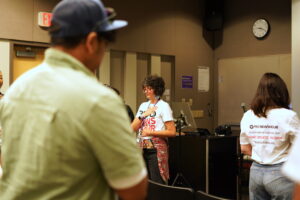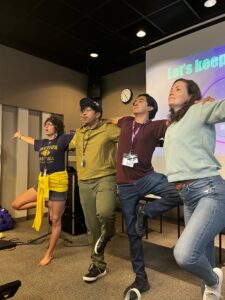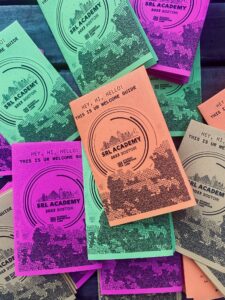5 WAYS TO BUILD COMMUNITY IN YOUR CLASSROOM
This blog post was written by Emily Hope Dobkin, SRL’s Community Engagement Manager
It’s the beginning of the school year. You’ve got your classroom all set up: stocked with fresh supplies, maybe some new equipment, a pristine, blank white board. It’s probably the most clean and organized this room will ever look for the year.
Enter: the students.
Enter: first week jitters, an air of anticipation, an undercurrent of excitement—along with awkwardness, confusion, nervousness, and probably some curiosity. It’s a blend of emotions and attitudes as you embark on this journey together…
So how do you establish connections? How do you forge those initial bonds? How do you build community?
Here are five ways to build community in your classroom:
1.) BREAK THE ICE
Whether you call them ice breakers, energizers, or brain breaks, there’s a variety of fun, simple prompts and activities that provide opportunities for your students to share about themselves, their interests, and their unique qualities. These kinds of exercises help set the foundation for deeper connections. They not only encourage communication but create a positive and inclusive environment where everyone can become more comfortable expressing themselves. Here are some of my favorites I’ve used when working with teens: Icebreakers. SRL’s Youth Media Producer, Chris Schwalm, also highly recommends using these Team Building Games from !Mpact Players.
 2.) REFLECT TO CONNECT
2.) REFLECT TO CONNECT
Incorporating reflective activities into your schedule is a great strategy for promoting mindfulness, self-awareness, empathy, and emotional regulation. The easiest way to do this: give each of your students a notebook (like these or these) and designate 5-10 minutes a few times a week for students to write. Let the pens ramble. In the digital age of typing and texting, handwriting is an art that allows us to tap into parts of our minds and hearts that are not regularly accessed. There’s a real power when putting pen to paper. Emphasize no one will be reading their writing. It’s for their minds to wander and explore, and for their eyes only.
Here are a few simple starter prompts:
- Today I…
- Write down three words you’re feeling and reflect from there:
- I’m thinking of…
I also recommend mind mapping. If forming full sentences feels overwhelming, this is a great alternative for folks to organize thoughts and ideas so that they have a way of looking at information from a bigger perspective. You can have students start with these initial words in the middle of a blank page: “my brain right now,” or simply, “today” and let their minds map where they are at.
These kinds of activities offer students a chance to pause from their projects and connect with their own thoughts and emotions. By carving out time for reflection, you’re also creating a climate that honors well-being while building trust.
NOTE: If you do choose to have students share their reflections, I suggest setting the tone by sharing this poem: Brave Space by Micky Scottbey Jones.
 3.) MOVE, STRETCH, BREATHE
3.) MOVE, STRETCH, BREATHE
Get up and move! Physical activity helps move stagnant energy that can accumulate during extended periods of sitting at desks or behind a computer, while totally invigorating your classroom. You don’t need to facilitate a full-on yoga flow; simple stretches not only work but establish a more energizing and dynamic environment.
Consider doing these:
- Do 10 jumping jacks and call them Exercise Snacks
- Take a wide stance, inhale your arms up, and wiggle your fingers; encourage students to wiggle their fingers and send good energy to the people around them. Yes, this is silly, yes it’s cheesy, but when you embrace the corniness of it all— you’re actually unlocking a powerful tool to melt away that initial awkwardness. It helps create a space of approachability, where barriers are lowered, connections are sparked, and a sense of community can take shape.
- Invite everyone to stand up, shake off any restlessness, then: take a deep inhale and exhale to the sound of a hearty “HA” —encourage students to get loud! Do this three times. This might feel uncomfortable, but again: you’ll be dissolving the weirdness and encouraging students to connect to themselves in a more holistic and integrated manner.
Whatever kind of movement you do, I suggest wrapping it up with one collective group clap (i.e. countdown “3…2…1: clap!” This seemingly simple action has the ability to unite the group in a strong sense of togetherness.
ADDITIONAL RESOURCES:
- Kindness in the Classroom From our friends at PBS Wisconsin, this free-to-use lesson guide has been developed to support mindfulness practices with young learners using the senses, breath, and body movements.
- Guided Meditations for teens Body scans, breathwork, movement, and more.
 4.) MAKE ZINES
4.) MAKE ZINES
If you’ve participated in an SRL Academy or Teacher Workshop in the last two years, you’re likely aware of my passion for zines—especially: mini zines. I love making mini zines because they can teach and share information that might otherwise be down as a menu, program, or informational guide. Beyond their aesthetic charm, mini zines offer a personal, hand-crafted touch that distinguishes them from your average handouts. Plus, they are pocket-sized: cute AND convenient. Check out this one made by SRL Educator, Tricia George, all about Media Literacy (Tricia also shares how to fold mini zines! An artform itself).
Suggestions for zines you can create for or with your students:
- (NAME OF YOUR CLASS) 101: Basic info that includes a warm welcome note, passwords, important dates, reminders, and classroom rules/ classroom contract
- STORYBOARD: Using our Find Your Story worksheet, create an interactive zine where students can fill in the blanks on each page, i.e. page 1: IDEAS, page 2: BACKGROUND INFO, page 3: CONSIDER NEWS VALUES, page 4: POTENTIAL SOURCES, pages 5 + 6: DEVELOP A PITCH
- HOW TO ____: Have students create their own step-by-step guides for various parts of media making, i.e. “how to set up a camera,” “ how to edit a story”, “how to interview” —making plenty of copies of these zines, and set up your very own D.I.Y’brary in your classroom…which can be as simple as filling a shoebox with zines and labeling it “D.I.Y.BRAY.”
PRO TIP: Use QR codes that link out to important resources. And don’t hesitate to reach out to me for assistance in brainstorming ideas or seeking feedback 🙂
5.) CO-CREATE CLASSROOM PLAYLISTS
Music holds the power to uplift and boost moods. Inviting students to contribute their favorite pump-up jams or songs of the season, followed by collaboratively crafting a playlist (I use Spotify), offers a super fun approach to community building within your classroom. This process provides a platform for students to express their individual tastes, nurturing a connection to music and quite possibly allowing unexpected connections to be found among themselves. And hey, if you’re lucky: maybe years from now they will revisit this playlist and experience a wave of nostalgia while reminiscing about their favorite class ever…
Through these varied shared experiences, students have the chance to discover commonalities, embrace vulnerability, and develop a more thoughtful understanding of each other. The results? Likely more participation, more productivity, and all-around positive vibes as you kick off a new semester.
How does community take root in your classroom? We want to hear from you! Share your icebreakers, tips, and facilitation strategies. Email Emily Hope Dobkin by September 8 and we will compile these valuable resources to share widely with our SRL community.






